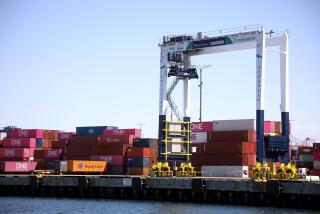Newest energy source: cow patties
Imagine a vat of liquid cow manure covering the area of five football fields and 33 feet deep. Meet California’s most-alternative new energy.
On a dairy farm near Fresno, manure is being turned into natural gas for use by PG&E; in what the utility hopes will be a new way to power homes with renewable, if not entirely clean, energy.
The Vintage Dairy Biogas Project, the brainchild of lifelong dairyman David Albers, aims to provide the natural gas needed to power 1,200 homes a day, Albers said at the inauguration ceremony for the facility in Riverdale.
“When most people see a pile of manure, they see a pile of manure. We saw it as an opportunity for farmers, for utilities and for California,” Albers said.
In addition to being a partner in the 5,000-head Vintage Dairy, Albers is also president of BioEnergy Solutions, the company that funded and built the facility, which cost millions of dollars. PG&E; is simply a customer and the companies declined to give details of project finances.
As cow manure decomposes, it produces methane, a greenhouse gas more potent than carbon dioxide. Scientists say controlling methane emissions from animals such as cows would be a major step in addressing climate change.
Enter the Vintage Dairy project. As luck would have it, methane can be captured and treated to produce renewable gas, and California regulators have directed PG&E; and other utilities to make renewable energy at least 20% of their electricity supplies by 2010.
PG&E; expects to reach 14% this year, thanks in small part at least to its partnership with BioEnergy Solutions.
To tap the renewable gas from cow manure, the Vintage Dairy farm first flushes manure into a large, octagonal pit where it becomes about 99% water. It is then pumped into a covered lagoon, first passing through a screen that filters out large solids that eventually become the cows’ bedding.
The covered lagoon, or “digester,” is the size of nearly five football fields and about 33 feet deep. It is lined with plastic to protect the groundwater, and the cover, made of high density polyethylene, is held down at the edges by concrete. The digester’s cover was sunken into the lagoon recently, and officials said it would be taut and raised in a few days as the gas collects underneath it.
Weights on top of the digester channel the gas to the small facility where it is “scrubbed” of hydrogen sulfide and carbon dioxide. The end product is “close to 99% pure methane” according to BioEnergy Chief Operating Officer Thomas Hintz.
Once it is treated, the gas is injected into PG&E;’s pipeline, where it will be shipped to a power plant in Northern California.
According to Albers, PG&E; and state officials, biogas is a major opportunity for dairy farmers to make extra revenue while helping the environment.
“There are a lot of lagoons like this in California that don’t have lining in them,” said James Boyd, commissioner of the California Energy Commission. “There is a business case to be made for this . . . climate change has really provided the incentive to do this.”
Both BioEnergy Solutions and PG&E; are actively courting dairy farmers, whose cow manure is now simply being used as fertilizer, allowing the methane to be released into the air as a greenhouse gas.
“With nearly 2 million dairy cows in California, the potential is great,” said Roy Kuga, vice president of energy supply for San Francisco-based PG&E.; The company has a partnership with another company, Microgy, which is setting up biogas projects at three California dairies.
In practice, however, not every dairy could participate in such a project because some are not close enough to the necessary gas transmission lines, PG&E; officials said.
More to Read
Inside the business of entertainment
The Wide Shot brings you news, analysis and insights on everything from streaming wars to production — and what it all means for the future.
You may occasionally receive promotional content from the Los Angeles Times.










